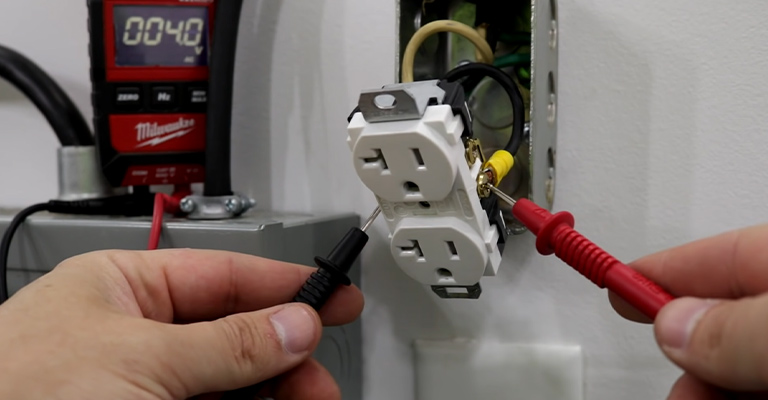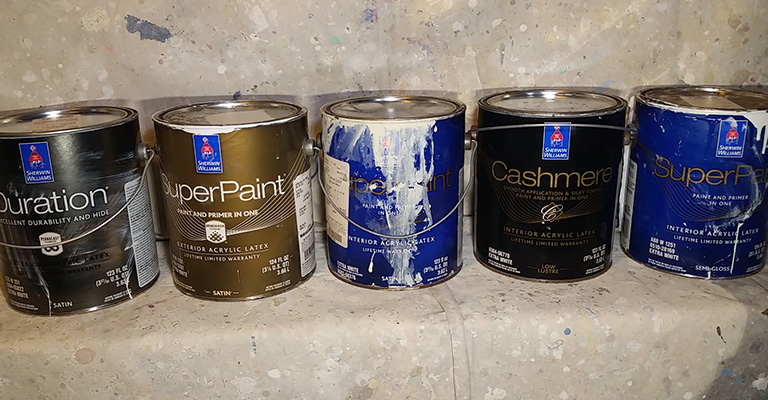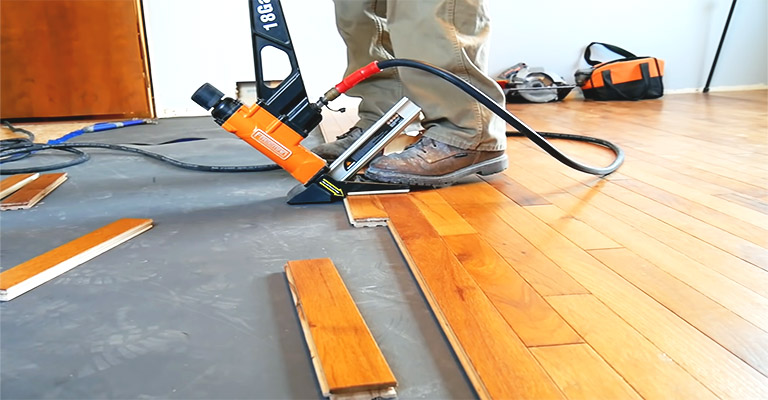How We Protected Our Vegetation From Freezing Temperatures
Final month’s arctic blast introduced surprisingly frigid temperatures to Florida. We had three consecutive nights with temperatures within the low 20s – and an final low of round 18 levels! Plenty of our outside crops aren’t constructed for that type of freezing climate (within the 3 winters we’ve spent right here we are able to bear in mind one different low of about 32-degrees, however issues went proper again as much as our extra regular lows of round 45 levels inside a couple of hours). They’re calling our current deep freeze a “once-in-a-century occasion” right here in Florida. In different phrases: the last word take a look at. So listed here are the steps we took to guard our crops, together with a couple of issues that labored higher than others.
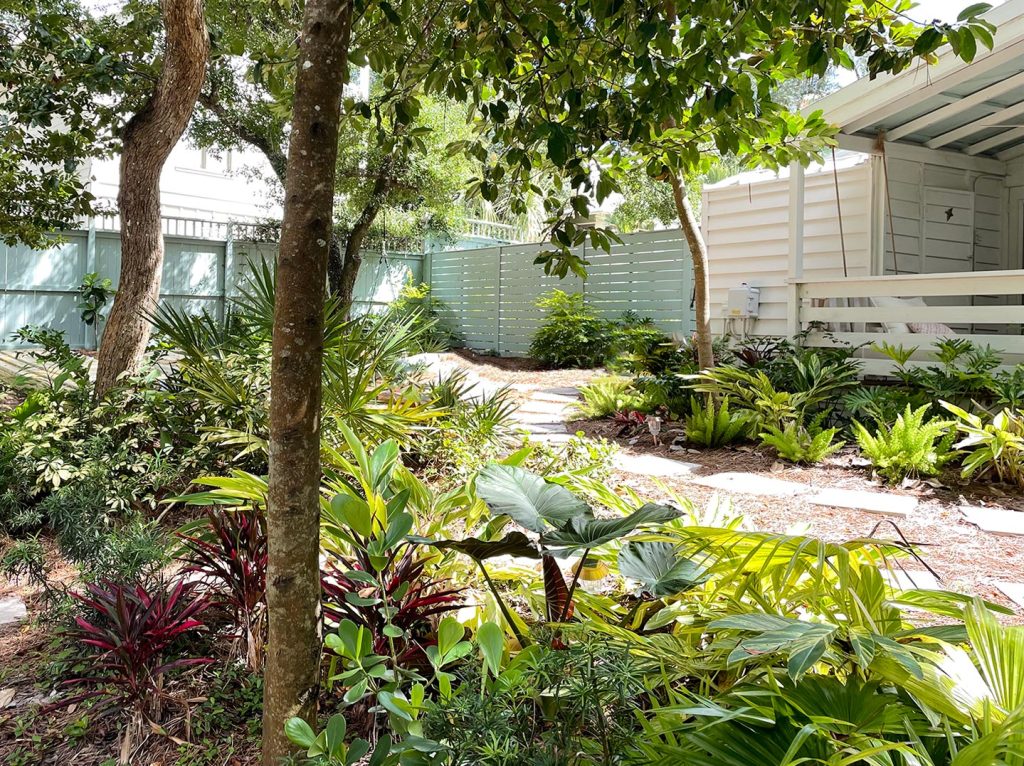
It must be mentioned that there are undoubtedly greater issues to fret about throughout excessive chilly climate occasions – like defending individuals, pets, and pipes. However you’ll usually see crops because the 4th “P” on that record of issues to verify on in freezing climate. And since we’ve spent a very good quantity of money and time on our landscaping, we figured it was well worth the effort to guard what we may, particularly if some up-front effort may save us the money and time of replanting issues that might in any other case die with out a little assist.
Tip 1: Establish Vegetation Weak To Freezing
To prioritize your efforts, attempt to study which crops are the least able to surviving in your forecasted temperatures. Presumably, most of them are designed to outlive in your rising zone (discover your zone right here). Nevertheless, that may not be sufficient info if the climate is predicted to be abnormally chilly – particularly for 3-4 days in a row. Going into this “exhausting freeze” we googled “chilly tolerance” or “chilly hardiness” together with the title of every plant we had exterior.* It’s an incredible start line for studying which crops we must always deal with, and which might hopefully be simply superb. For instance, we realized that our noticed palmettos wouldn’t want our assist, however our foxtail ferns would possibly.
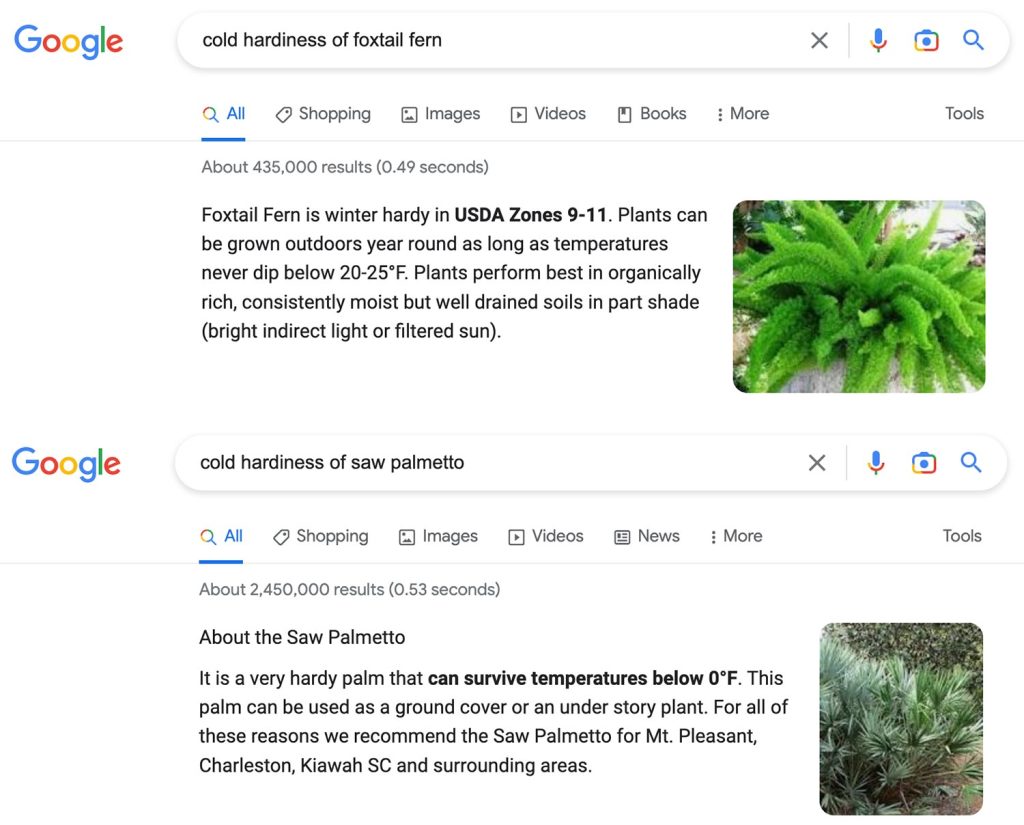
*NOTE: Should you don’t know the title of your plant, your iPhone digicam may help (totally free!) or attempt an app like PictureThis.
Tip 2: Carry Vegetation Inside, If Potential
The surest approach to preserve your crops from getting too chilly is to convey them inside the place it’s heat. After all, that is simpler mentioned than executed. Many crops is likely to be dug within the floor, too heavy to maneuver, and/or too huge to suit indoors. However issues like small-to-medium pots or hanging planters are good candidates for transporting inside. You’ll need to be the decide of what’s affordable in your residence.
As you’ll see in these footage, we now have A LOT of potted crops exterior. Some would possibly name us loopy for bringing so many inside – particularly contemplating we’ve received a small residence and this freeze was occurring whereas we had been celebrating Christmas. However we laid out some tarps by a few lesser-used doorways and crammed as many pots as we may onto them. The tarps protected the flooring from dust and any residual water within the soil (keep in mind that outside pots have drainage holes on the underside). It was barely inconvenient for a couple of days, however this turned out to be the one technique that had a 100% success fee.

By bringing so many pots inside, we most likely saved over $500 in crops that we would’ve needed to substitute in any other case. It was undoubtedly value it. Even when it did imply breaking out a dolly to tug our huge fiddle leaf fig off the entrance porch and into the kitchen! It really doesn’t look half dangerous in right here… aside from the truth that it made moving into the laundry closet kinda tight.

If bringing your crops indoors to your heated area isn’t attainable, even relocating them right into a protected space like a storage, basement, or attic could possibly be sufficient to maintain them alive. Potted crops are particularly susceptible to chilly as a result of their soil is much less insulated than these dug into the bottom. And getting them out of the wind helps to reduce warmth loss.
Tip 3: Add Pine Straw Or Mulch
For crops staying exterior, your essential technique helps them keep as heat as attainable. One method is so as to add a layer of recent mulch to your plant beds, particularly across the bases of your crops. Mulch really helps lure air round your crops – notably when utilizing a lightweight materials like straw or pine straw – which insulates them in opposition to dramatic drops in temperature. It may possibly additionally assist retain moisture and, surprisingly, moist soil really retains extra warmth than dry soil.
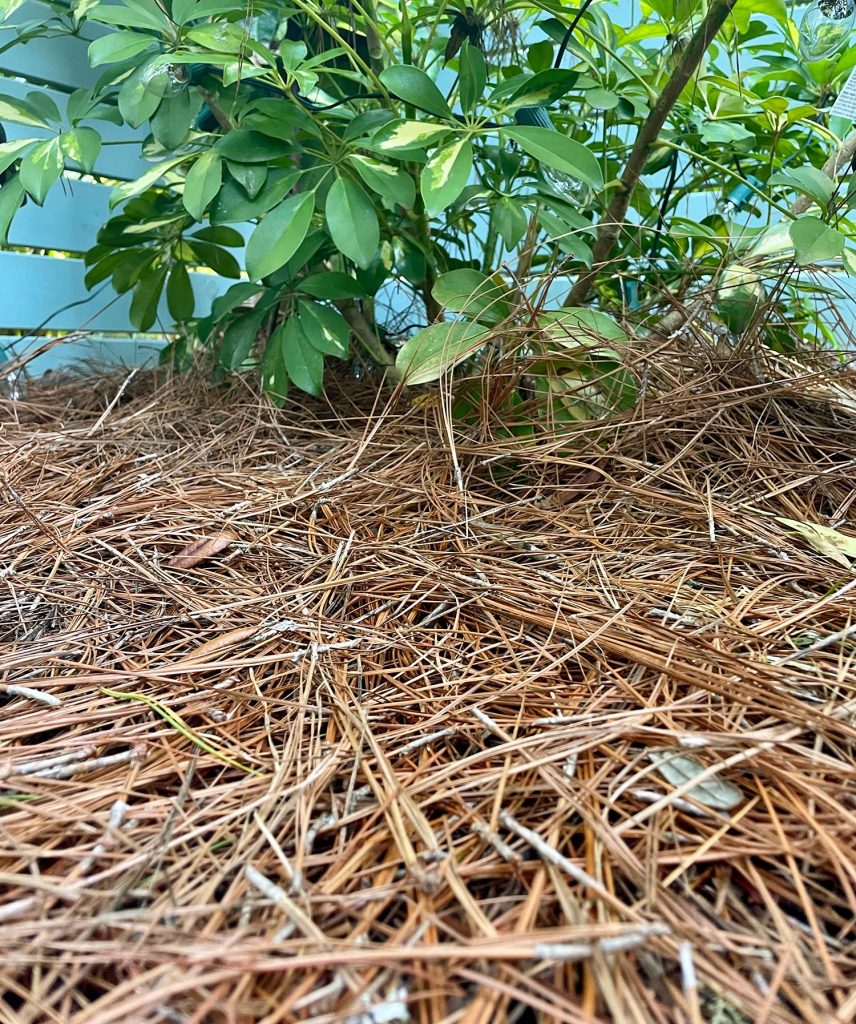
Mulching does require a little bit of time, effort, cash, and planning. Fortunately, we already had plans so as to add recent pine straw to our yard as a result of we had friends visiting for the vacations. We needed the clear look of freshly mulched beds and the chilly safety was a pleasant bonus! It’s additionally an incredible tip to water your whole freshly mulched crops earlier than the chilly. As I mentioned above, we had been stunned to listen to that as a tip from a variety of native backyard facilities – however moist soil retains extra warmth than dry soil. So sprinkle away.
Tip 4: Cowl Vegetation With Breathable Material
Should you’ve ever seen somebody throw a blanket, towel, or sheet over their crops, that’s one other widespread approach to attempt to preserve some warmth round your crops. The duvet traps heat air across the plant in the identical method {that a} blanket retains us people heat – however as a substitute of trapping physique warmth, it retains the warmth that’s coming off the plant and soil. We figured it wouldn’t be foolproof with such low forecasted temps, however we knew even when it saved half of what we coated it might be value it. And we picked up some tricks to make it as profitable as attainable that we’ll share with you under.
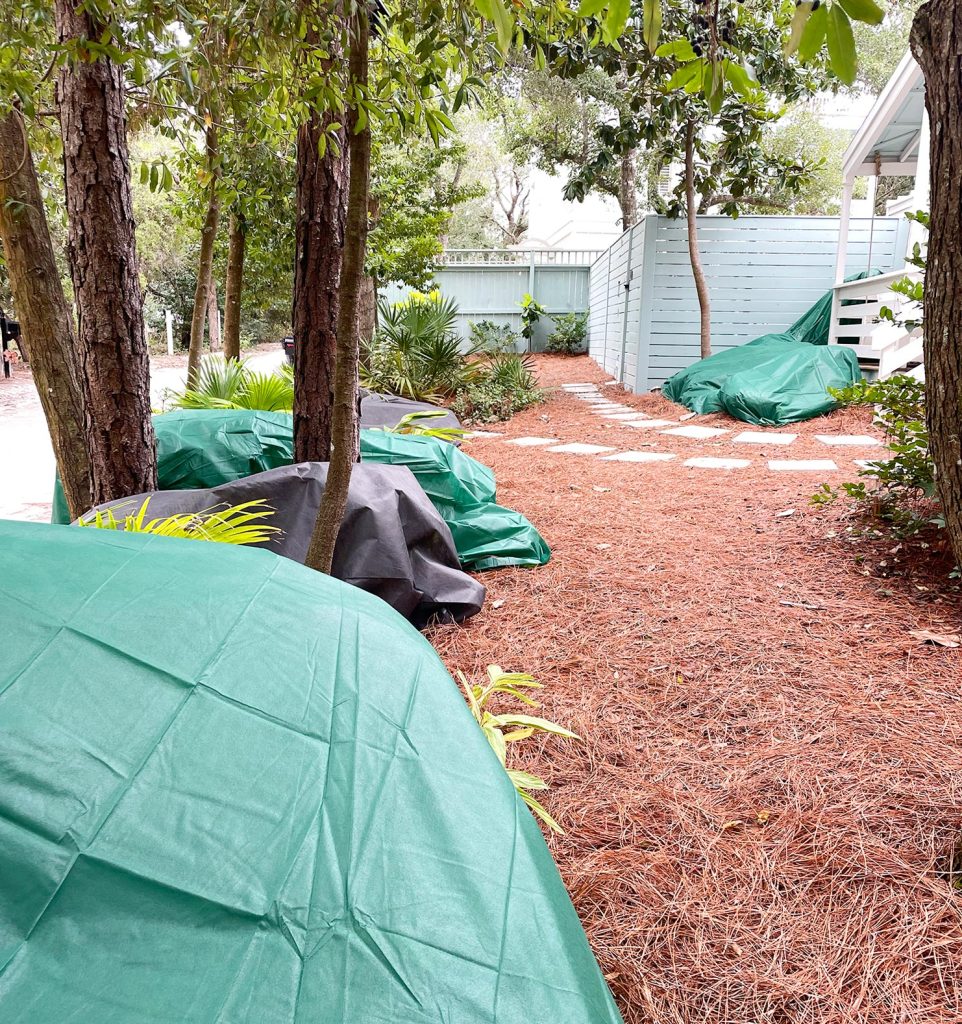
Use breathable material, not plastic
It might sound counterintuitive however utilizing breathable material so air can nonetheless move across the plant was the primary tip from native nurseries and on-line plant consultants alike. We learn over and over {that a} plastic drop fabric or plastic bag may be worse than no safety in lots of instances, since it may possibly maintain moisture in opposition to plant tissues and trigger extra critical freeze harm. Simply take into consideration the way you’d really feel coated in plastic vs material. Not enjoyable, proper? That’s why issues like spare bedsheets or towels are good options that you could be have already got round.
Should you can’t discover frost blankets, attempt panorama material as a substitute
We don’t have many spare sheets, so we purchased a number of of those Frost Blankets after we first noticed the forecast. However a couple of days later, after we went again to seize a pair extra, the shop was utterly offered out. Fortunately, somebody there instructed us that panorama material – the type meant to dam weeds – is the same materials, making it an appropriate substitute. We discovered it to be a bit thinner than the Frost Blankets, however it was additionally cheaper. And in the long run, they each appeared to carry out about the identical.
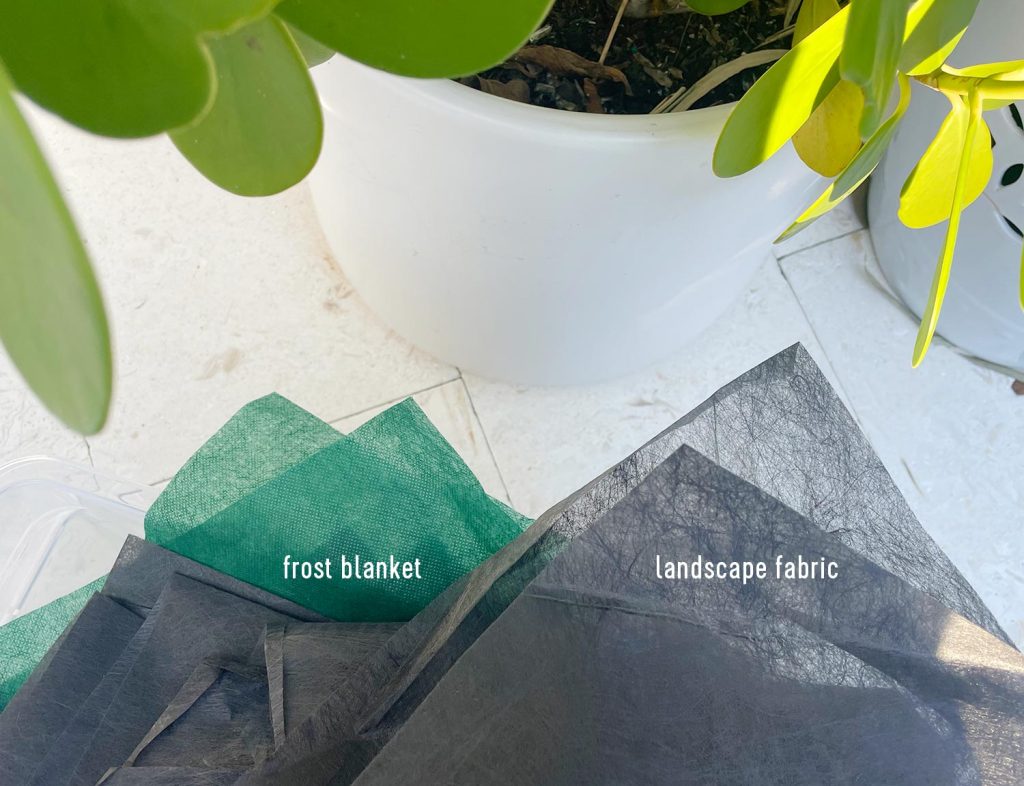
Don’t “lollipop” your crops
Be certain your blankets go all the best way to the bottom. Your soil is the primary supply of the warmth that the blanket can be trapping, so simply wrapping the leafy prime (like a lollipop wrapper) isn’t as efficient. When draping bushes or small bushes, suppose extra about making “ghosts” the place your cowl makes contact with the bottom on all sides. Additionally, don’t overlook to purchase some backyard stakes or panorama pins to maintain your covers held down – particularly if it’s going to be windy!

Tip 5: Add An Ambient Warmth Supply
To extend the quantity of heat air your blanket will lure, you can even introduce one other warmth supply. Somebody tipped us off that wrapping incandescent Christmas lights round your plant or by means of your plant beds is a good way to do that. LEDs received’t work as a result of they don’t give off warmth, however the old-school ones – particularly the bigger C9 bulbs – are barely heat and recognized to work properly. Simply watch out to not overload your breakers with too many strands. Right here’s what ours appeared like earlier than we coated them.
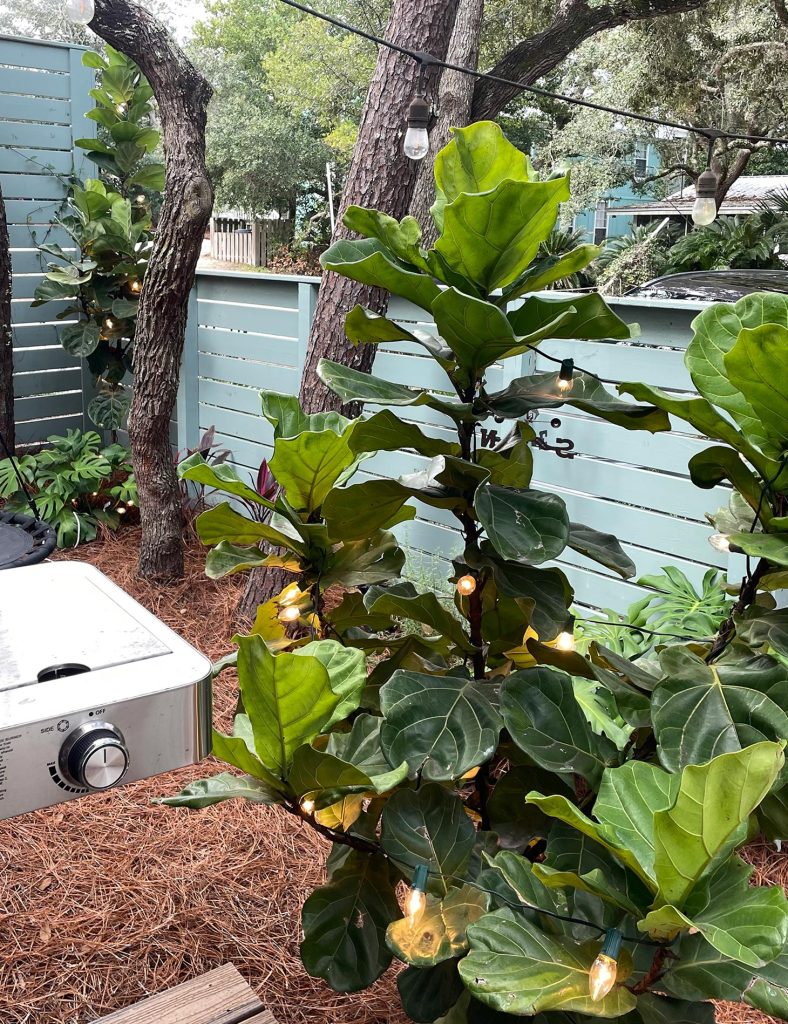
And right here’s what they appeared like after we put the frost blankets over them. I used to be kinda fairly, in a spooky form of method!
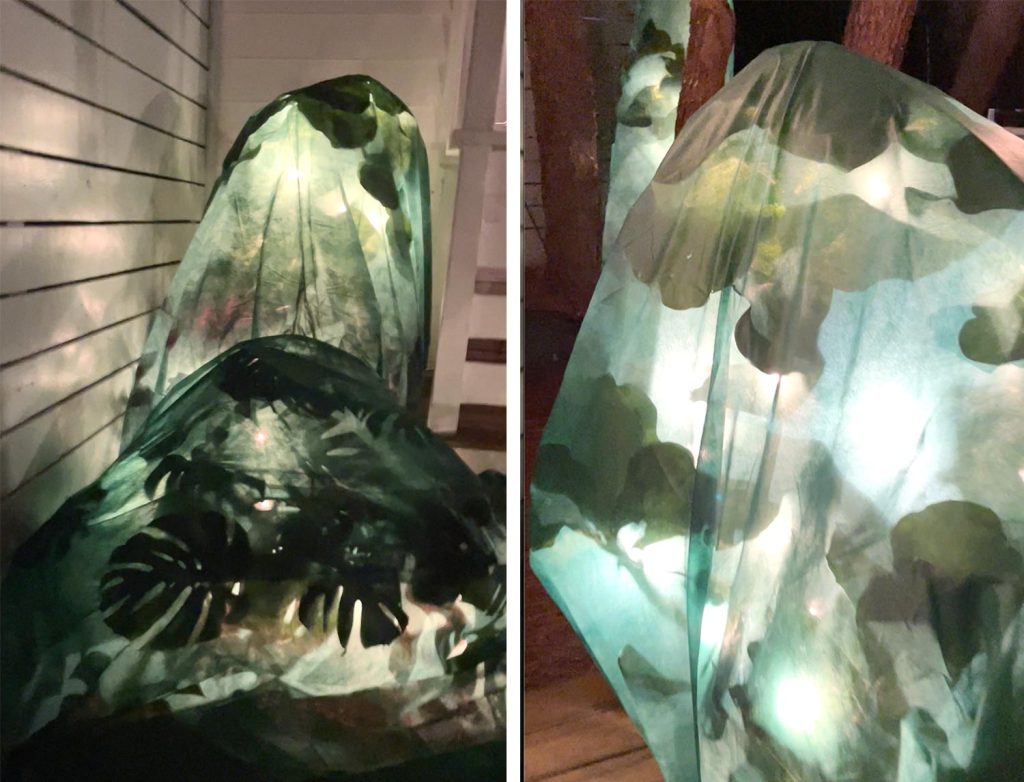
We’ve additionally heard of individuals filling milk jugs with scorching water and putting them close to their crops. The identical precept is at work, however this gave the impression of a extra labor-intensive method. Plus, since this was occurring on Christmas weekend for us, we had no hassle discovering loads of discounted C9 bulbs on the retailer. We received 4 containers for the value of 1!
How Did Our Vegetation Fare?
After taking the entire above actions, I’d like to say that our landscaping seems nearly as good because it did earlier than the chilly snap (see the way it appeared this fall right here). It undoubtedly doesn’t. Regardless of our efforts, we, sadly, have a variety of crops – particularly tropicals – that simply aren’t constructed for the acute sustained “exhausting freeze” that we skilled for 3 strong days in a row.
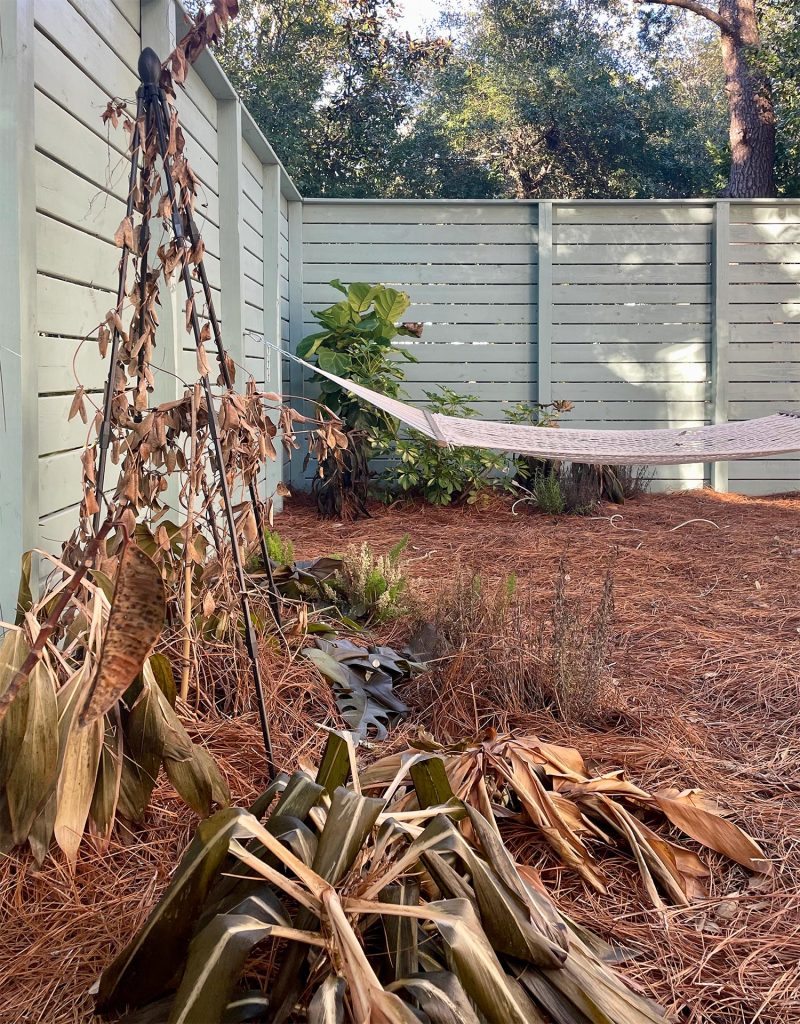
I want there was a transparent takeaway like “blankets work” or “C9 bulbs are superb each time” however our outcomes had been too combined to attract such decisive conclusions. Some coated crops did nice (as in, they appeared pristine after we uncovered them) and a few didn’t. It’s probably that many if not all of our coated crops would possibly come again based mostly on the bottom/root seeming to be unaffected and solely the leaves trying limp (sometimes leaves can come again if their root/stem is okay) however they don’t all look nice proper now. We’ll need to replace you on how issues fare, so keep tuned for that.
However our overview is that whereas some coated crops had lights and a few didn’t, each teams had some crops that appeared nice upon uncovering them and a few actually wilted ones (which once more would possibly utterly come again, however they don’t look nice now). As soon as once more: bringing crops inside was the one 100% success fee we had.
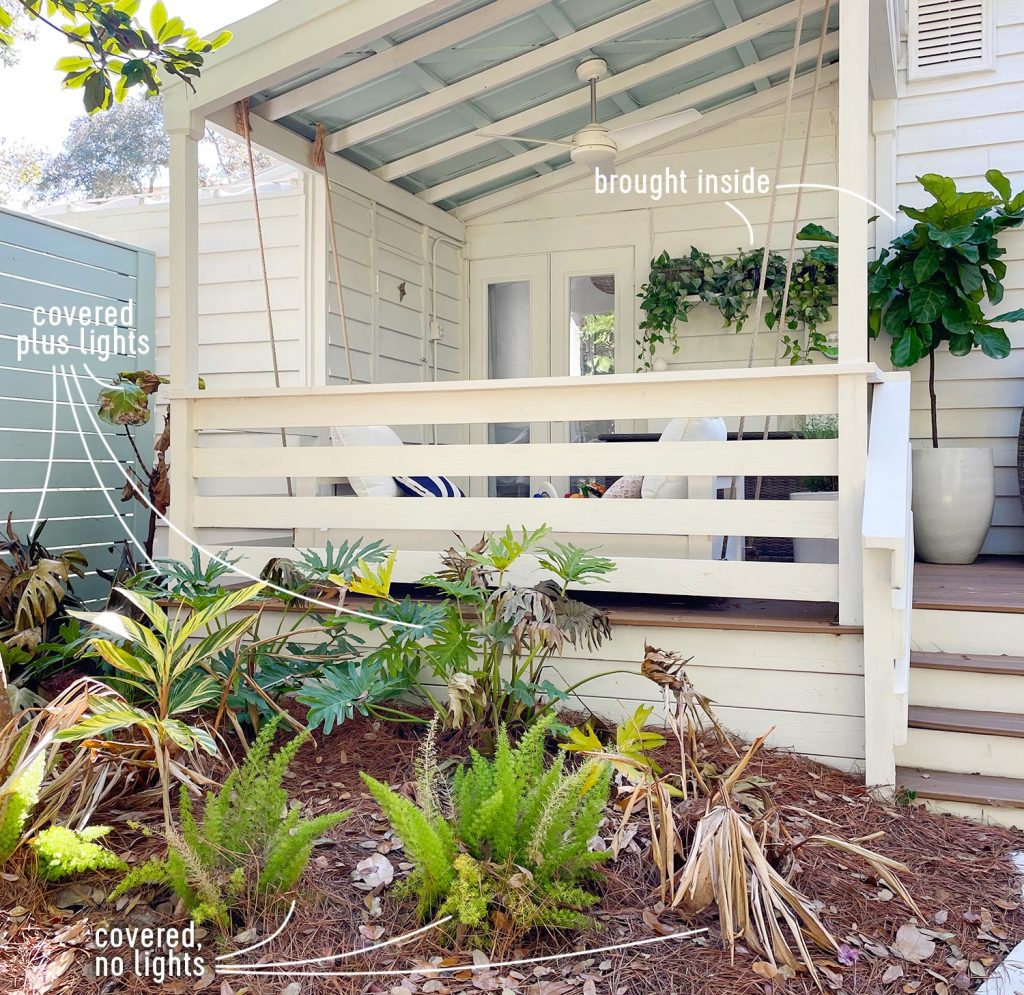
We predict a variety of this “diversified consequence” could possibly be associated to particular plant species and planting places. As an illustration, certainly one of our lime bushes seems utterly superb (see under) and the opposite is principally coated in brown leaves and all of the fruit dropped off. Each had been mulched and coated, however with out C9 bulbs. Our greatest guess is that one was much more uncovered to the wind than the opposite one for the reason that happier one (seen under) was in a nook the place there have been two fence sides as wind breaks. Most of our extra tropical crops like monsteras, elephant ears, and gingers received fully limp, however our philodendrons fared okay with at the least a couple of happy-looking leaves and a base that’s already capturing up new wholesome leaves.
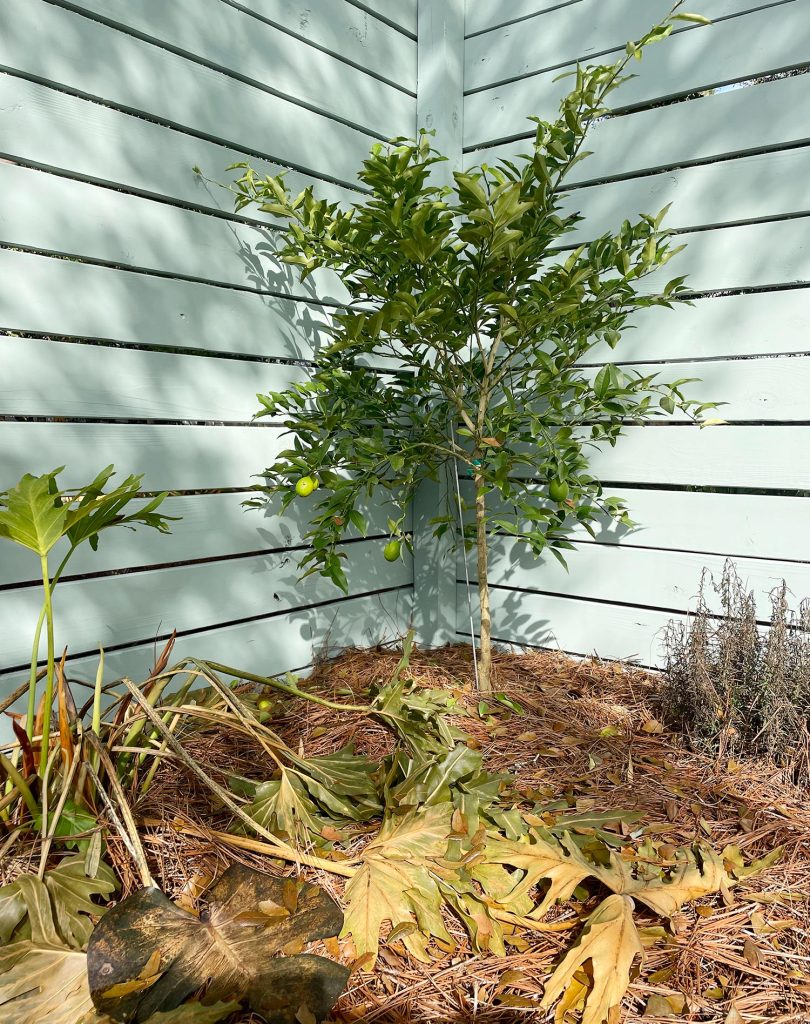
We’ve a number of fiddle leaf figs planted exterior as a result of we’ve had higher luck with them open air right here than inside. Over the previous 3 winters they’ve been exterior & very completely satisfied, so we introduced within the potted one which we may, and for those that had been planted within the floor, we coated, mulched, and wrapped them in Christmas lights. The outcomes? One one got here out utterly unscathed (under proper). And, to our shock, it was the smallest and most just lately planted of the entire bunch. In reality, that complete mattress it was in did fairly properly. So possibly it was simply in a hotter nook of our yard which as soon as once more had two fences assembly to kind a wind break round it?
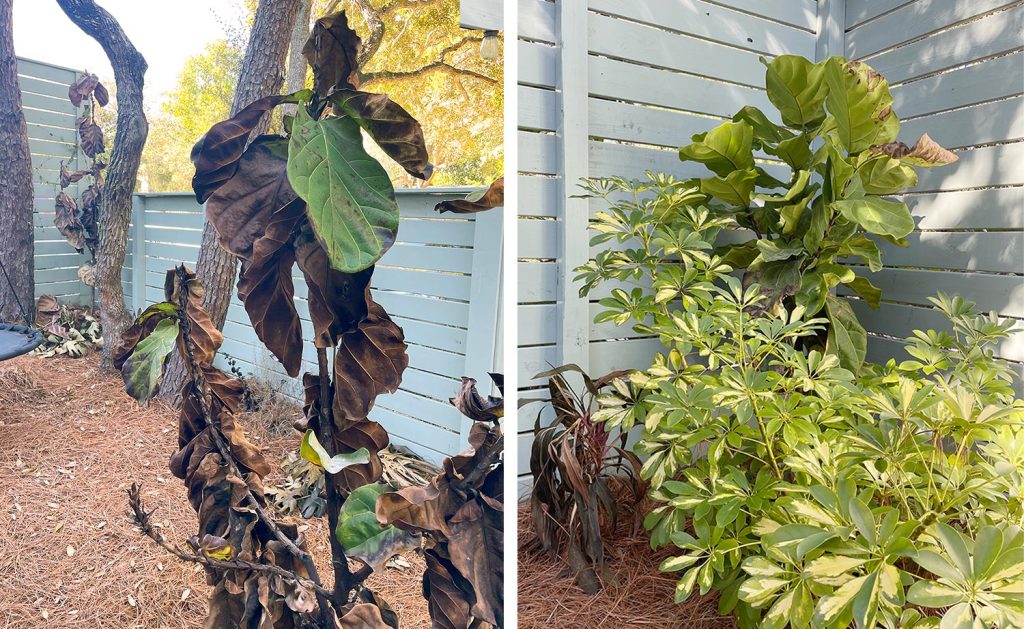
The one motive we really feel okay in regards to the different figs trying so bleak is that we now have seen a fiddle leaf fig utterly die within our home (dropped all leaves, was a dead-looking stick) and after we put it exterior it utterly regrew into a brilliant big and wholesome tree. So we’re holding out hope that occurs once more with these. Will preserve you posted for certain.
So, once more, it’s exhausting to attract clear conclusions about what of this effort labored… at the least not but… however it feels protected to say that it didn’t harm to try to we now have excessive hopes for a lot of issues coming again this spring. (*crosses all fingers and toes*)
What’s The Good Information?
As I’ve talked about in the case of limp crops or brown leaves, all hope will not be misplaced. There’s an enormous distinction between a useless leaf and a useless plant, so simply because a number of our leaves are brown and wilted, doesn’t imply the entire plant’s a goner. They might simply want time to shed their frozen bits and regrow new ones when the climate heats up once more. In reality, a few of our crops have already began to indicate indicators of life (it has been about 3 weeks for the reason that freeze).
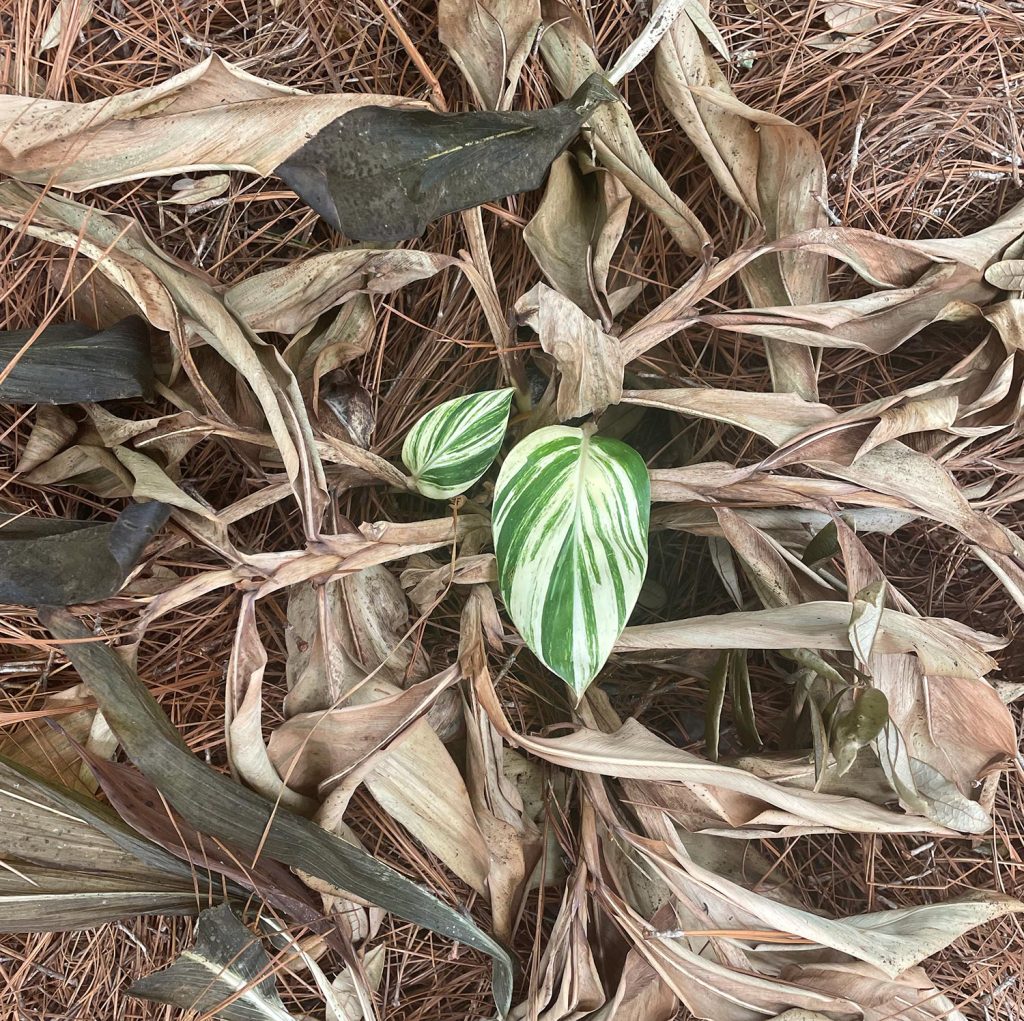
So not solely do you have to not leap to conclusions about what survived and what didn’t, this leads us to our final tip…
Tip 6: Don’t Prune Proper Away
As antsy as we’re to scrub up the entire dead-looking crops in our yard, most of the consultants we googled (and chatted with domestically) say that our crops will really do higher if we wait. Suggestions differ barely from plant to plant, however typically, listed here are some causes to place your shears away (for now):
You would possibly lower off wholesome branches or dig up wholesome crops
You most likely received’t know what components of the plant are really useless straight away. Some harm could not seem instantly, whereas some rough-looking crops could bounce again in a couple of days. Nonetheless, others received’t sprout once more till the spring. You wouldn’t decide the well being of a tree based mostly on its empty branches within the winter, proper? So by ready for issues to begin greening up once more, you’ll have a a lot clearer concept of what crops (or components of your crops) didn’t survive.
Useless leaves can nonetheless defend your plant
Till you’re previous your space’s final attainable frost (verify your frost dates right here) there’s at all times an opportunity you’ll expertise one other chilly snap this season. That useless materials can nonetheless supply some insulation to the residing components of the plant, whereas eradicating them leaves every plant extra uncovered to chilly and wind than earlier than.
You don’t need to stress your plant extra
After a freeze occasion, your plant focuses its assets on retaining its core alive and wholesome. That’s what you need it to do. Reducing branches or eradicating leaves too quickly would possibly set off a development response, which could unnecessarily “distract” its assets. Plus, if pruning does lead to new development, these new leaves grow to be much more susceptible to future freezes this season if one other chilly entrance rolls round.
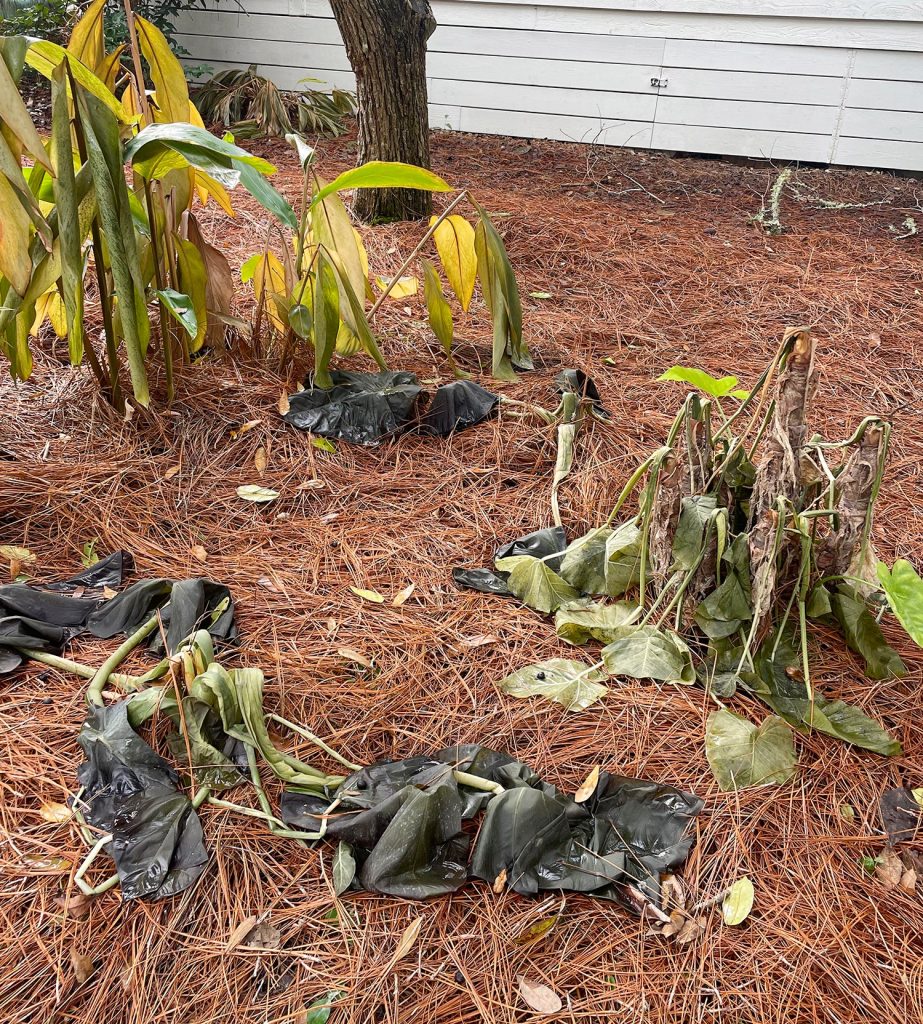
Usually, we’ve adopted the rule of letting broken leaves and flowers fall off on their very own (even when it means ready for brand spanking new development to push them off within the spring). However for something that’s mushy or gross, which tends to occur on some tropicals (see above), we take away that sooner to stop rot. This occurred to certainly one of our greatest elephant ears final yr throughout our one and solely transient frost, however it grew again simply as huge this yr. Fingers crossed it does that once more!
So although our yard doesn’t look fairly the best way we wish it to proper now, we’re reserving ultimate judgment on what labored and what didn’t till spring and summer season rolls round. We’re hopeful that extra issues survived than it appears and, if not, we’ll reevaluate if we need to threat replanting the identical factor as an alternative. A neighbor of ours mentioned she likes to take a look at these moments as a chance for issues to return again hardier and stronger, so we’re hoping that holds true for our crops.
Extra Freezin Climate Preparation
Our crops weren’t the one factor we took steps to guard throughout this current chilly snap. Because it was our first time having such low temperatures in our Florida home, we protected our pipes from freezing too. A number of of our neighbors skilled burst pipes – particularly of their outside showers. However fortunately the steps we took spared us from having the identical hassle!
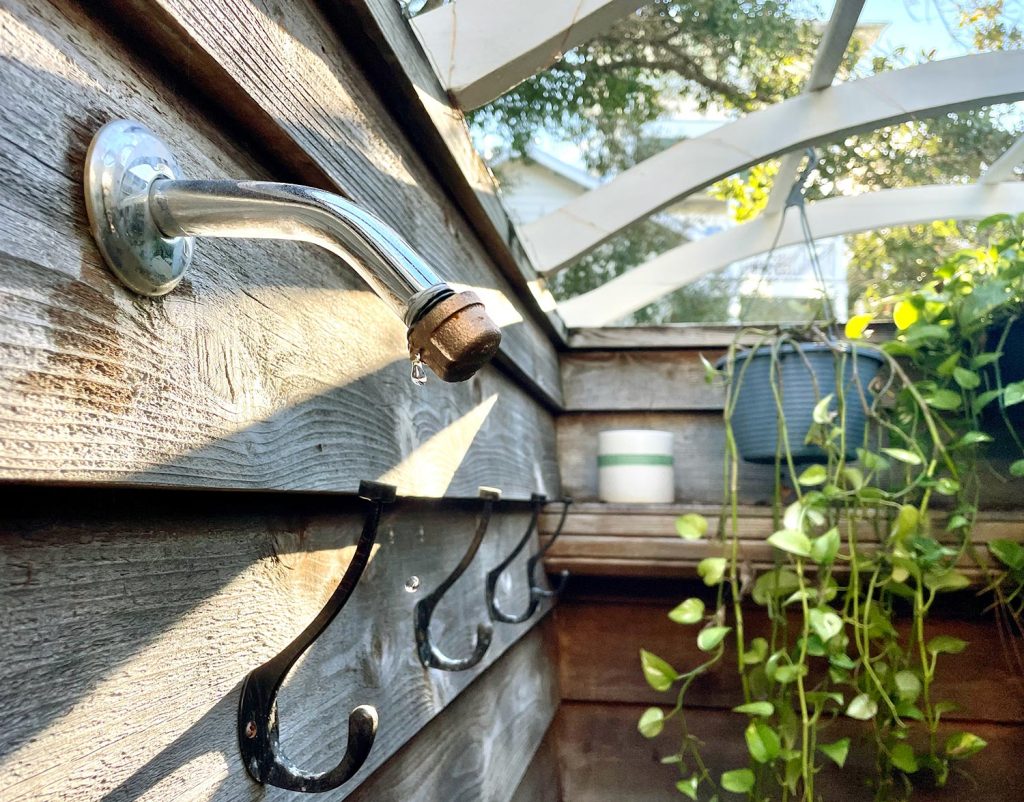
Our warmth additionally stayed on this time, which was a giant assist, however we’ve additionally written about the way to stop frozen pipes when your warmth goes out.
*This publish comprises affiliate hyperlinks, so we could earn a small fee if you make a purchase order by means of hyperlinks on our web site at no extra value to you.

